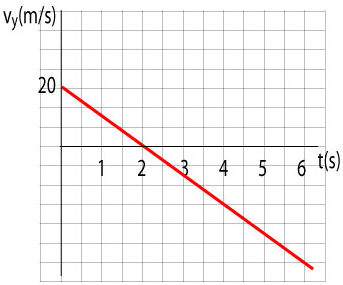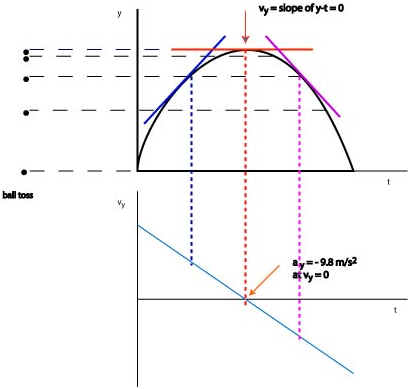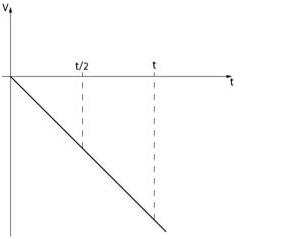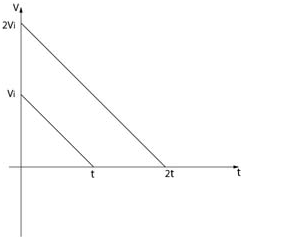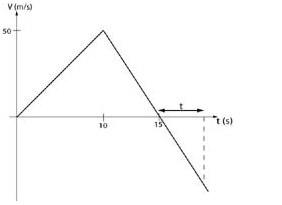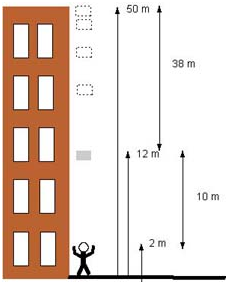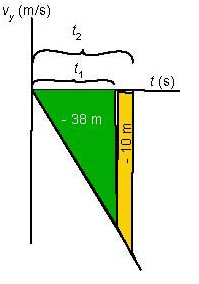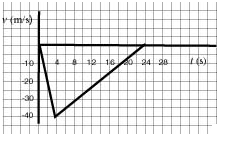Exercises on Free Fall Motion
Helena Dedic
Exercise 1
A baseball is thrown up at 30 m/s from the ground. Find:
(a) its velocity at a height of 25 m
(b) the time when its speed is 15 m/s and
(c) when its height is 40 m.
Solution:
It takes 3 seconds for the particle to reach its maximum height and 6 seconds for the entire flight. The height is equal to the area under the v-t graph:
(a)
(t-5)(t-1) = 0
t = 1 s, 5 s
(b)
15 = 30 - 10 t
t = 15/10 = 1.5 s
(c)
(t-2)(t-4) = 0
t = 2 s, 4 s
Exercise 2
A toy rocket is rising at a constant speed of 20 m/s. When it is 24 m above the ground, a bolt comes loose. How long does the bolt take to land? What is its maximum height? At what speed does it hit the ground?
Solution:
We will begin by sketching the v - t graph.
The rocket moves up at 20 m/s. It takes 1.2 s to reach the height of 24 m. At this moment a bolt falls off. It has the upward velocity of the rocket. It has a downward acceleration due to gravity and so it begins to slow down. Then it comes to a stop (the graph crosses t-axis and begins the downward fall. Since it has the velocity of 20 m/s and since the velocity is decreasing at a rate of 10 m/s per second it will take two seconds to come to a stop and then to begin the downward motion.
The sketch of the graph is below:
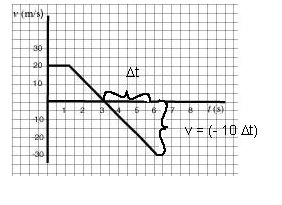
We can find the displacement of the bolt during the time it moved up from the area under the graph: 20 x 1.2 + ½x 20 x 2 = 44 m. Therefore the maximum height reached by the bolt is 44 m.
We note that in order to reach the ground, the area under the graph below t-axis has to be - 44 m. We note that the slope of the graph is. Therefore, the time t can be determined from the equation -44 = ½ x (- 10 t) x t. It yields the value t = 2.96 s. Therefore the total time of the free flight of the bolt is 2 + 2.96 = 4.96 s.
Since the bolt accelerates downward at it will approach the ground with a velocity - 29.6 m/s.
Exercise 3
Vinnie is standing on a cliff 50 m above the sea. He throws a pebble up in the air with initial velocity v0 y = 20 m/s. Use g = 10 m/s2.
a. Draw a sketch of vy versus t graph.
b. How long does it take the pebble to reach the top of its flight?
c. How long does it take the pebble to pass the spot where he threw it?
d. How long does it take the pebble to reach the sea?
e. How fast is the pebble going when it reaches the sea?
Solution:
a. We will use a positive axis pointing upward. The initial velocity in the free fall of the pebble is positive and therefore the the graph will begin above t-axis. The acceleration is negative . This means that the velocity is decreasing 10 m/s every second. It will take 2 s for the velocity to decrease to zero. The graph will be a straight line with a negative slope. It will cross the t-axis at t = 2 s.
b. We already have the answer for this question: 2 s
c. The pebble moves up during the first two seconds (we can find how much from the area under the curve ½ × 2 × 20 = 20 m). The pebble then moves down the same distance to reach the spot where Vinnie threw it and therefore it will take another two seconds. The total time is four seconds.
d. When the pebble reaches the sea it has moved from a point 50 m above the sea to a point at the sea level. The displacement is a vector pointing from the initial point to the final point. In this case the displacement points downward and has the magnitude of 50 m. In the coordinate system we have chosen the displacement is . We can use the equations of kinematics to determine
To solve this equation we will divide it by 5 and then use the quadratic formula to find that it took 5.74 s.
e. The question is about the speed of the pebble (not the velocity!) at t = 5.74 s. We can find the velocity from the graph or from the equations:
The speed is the absolute value of the velocity and so the pebbles moves with a speed of 37.4 m/s.
Exercise 4
A stone is thrown vertically up at 20 m/s from ground level. Find the times when it is at half its maximum height, and half its maximum speed.
Solution:
We will begin by sketching the v - t graph.
The ball initially moves up at 20 m/s - note that the velocity is positive (forward).
It is in a free fall and thus its velocity decreases at a constant rate of 10 m/s per second (straight line graph).
It will take two seconds to come to a stop (cross t-axis) and then to begin the downward motion. The sketch of the graph is below:
We have to find the time at which it reaches half of the maximum height.
Since the maximum height is the area of the triangle above t-axis we note that the maximum height is ½ x 20 x 2 = 20 m. The question is how to find the time when the displacement is 10 m. We have divide the triangle in two equal areas of 10 m - see the sketch below.
We can compute the area of the yellow shape or the area of the grey triangle.
Since the latter is easier, we assign a value t to the base and compute the area ½ x (10 t) x t = 10.
From this equation we find that t = 1.41 s. It means that the second 10 m is travelled in 1.41 s and then it follows that the first 10 m is travelled in 2 - 1.41 = 0.59 s.
It is important to note that it takes a lot less time to reach half of the maximum height than it takes to travel the second half of the maximum height.
The question when the ball has half of the maximum velocity or 10 m/s is easier. Given that the velocity decreases at a rate of 10 m/s per second, it will take 1 s or half of the time that the ball rises up.
Exercise 5
An object thrown verticlly up is instantaneously at rest at the highest point. What is its acceleration at that point?
Solution:
Velocity is the slope of the x-t graph which you can see is decreasing with time.
The graph shows that the change in velocity with time or the acceration is constant at throughout the motion.
Although the velocity is zero for an instant of time when the ball
is at the top of its motion, the acceleration is still -.
Exercise 6
Answer the following questions and explain your answers:
a. A ball dropped from a height H reaches the ground in t s. Can we say that it takes half of the time to reach half of the maximum speed?. (Hint: use a v - t graph to answer this question and to justify your answer.)
b. Assume that a ball is thrown straight up with some initial velocity vi. Can we say that the maximum height will double if we double the initial velocity? (Hint: use a v - t graph to answer this question and to justify your answer.)
Solution:
a. The ball is dropped from a height H. This means the initial velocity is zero and velocity decreases at a rate of -10 m/s per second. When the ball reaches the ground at, say, time t, the area under the v - t graph is H. The v - t graph drawn below reflects these conjectures:
Since the triangles bounded by the graph and the vertical dashed lines drawn through t/2 and at t are similar, the ratio of their sides are the same. In particular, this means the ratio of the vertical segments is the same as the ratio of the horizontal segments. Since the lengths of the vertical dashed lines are equal to the corresponding velocities, we conclude the ratio of the velocities is the same as the ratio of their corresponding times.
b. The ball is thrown up with some velocity which is positive, and the velocity decreases at a rate of -10 m/s per second. When the velocity reaches zero, the area of the triangle is equal to maximum height. We will draw two graphs: one corresponding to initial velocity vi and one to initial velocity 2vi - see the graph below:
Again, we are dealing with similar triangles so that ratios of corresponding sides are equal. Since the vertical side of the larger is double the vertical side of the smaller triangle, the horizontal length of the larger is also double that of the smaller. In other words, since the velocity doubles the ball will take twice as long to come to rest. The area of the larger triangle is then ½ (2 vi) (2 t) = 4 (½ vi t). Therefore, when the initial velocity doubles, maximum height increases by a factor of four.
Exercise 7
A toy rocket is fired from the ground (from rest). It moves up with a constant upward acceleration of for the first 10 seconds while its fuel lasts. It then continues to move up until it reaches its maximum height. Once the fuel is exhausted the rocket is in a free fall. What is the maximum height and the time of flight of the rocket?
Solution:
We will plot the v - t graph. The rocket starts at rest and therefore its initial velocity is zero. It accelerates at for ten seconds and therefore it will have an upward velocity of 50 m/s at t = 10 s. From then on the rocket is in free fall and therefore its velocity will be decreasing at a rate of 10 m/s every second. Consequently, the rocket will come to rest (v = 0) at 15 s. It will then begin to move backwards (down). The v - t graph will be below t-axis. We draw the graph as follows:
To find the maximum height we have first to figure out the displacement while the rocket moves forward during the first 15 s.
The area under the curve is ½ × 50 × 15 = 375 m. To determine the time of flight we have to find how long it takes to move backward 375 m.
Let t be the time so that the area under the curve below the t-axis is ½ t (- 10 t) = - 375 m.
Solving for t we find t = 8.66 s. The total time of flight is therefor 23.66 s.
Exercise 8
A cement block accidentally falls from the roof of a 50 m tall building. When the block is still 12 m above ground, a pedestrian--who is 2 m tall--looks up and sees the block is directly above. How long does he have to get out of danger's way?
Solution:
The block has initial vertical velocity 0 m/s and speeds up as it moves towards the ground. When it is 12 m above the ground, or, when it has already fallen 38 m, the man notices the block is directly above. Since the man stands 2 m tall, the distance between them is really only 10 m. Thus we can say that the block has only to fall a total of 48 m before it hits the pedestrian. We get the following picture:
Now, let us choose coordinate system so that the pedestrian stands at the origin with positive y-axis pointing up. The vy - t graph is therefore the straight line passing through the origin with slope -10 m/s/s (which is the rate of acceleration).
To determine the time he has to move out of the way, we will determine the time it takes the block to fall through the initial 38 m by measuring the corresponding area under the graph: -38 = ½ × (- 10 ). We get. We then determine the time it takes the block to fall through the initial 48 m, and find, from the equation -48 = ½ × (-10 ) (which is again just the corresponding area under the graph) that . This way we see that he does not have much time--only 0.3 s (which is very close to the average reaction time). This means he has to be pretty alert in order to escape injury!
Exercise 9
Wiley E. Coyote dropped from a cliff. He fell for 4 s before he remembered that he had a rocket that could give him an upward acceleration of 2 m/s2. He fired the rocket and managed to land on the ground softly with zero speed.
a. How high is the cliff?
b. How long did it take him to reach the ground?
Unfortunately, our friend did not remember how to turn the rocket off and so he did not stay on the ground for long. As usual!
Solution:
Coyote dropped from the cliff which means that the initial velocity is zero. As usual we will choose to orient axis upward as positive (forward). In this sense, he will be falling backward all the time.
Once off the cliff, he speeds up because his velocity is decreasing at a rate of - 10 m/s every second. Note that the preceding expression is synonymous with an expression "the acceleration is - 10 m/s/s".
The graph will be a straight line with a negative slope.
At 4 s he fires a rocket and begins to slow down because he has a positive upward acceleration of 2 m/s/s. Since the acceleration is constant, the v - t graph will be a straight line with a positive slope. Eventually his speed decreases to zero at which point he lands on the ground. The sketch of the v - t graph is below.
Since the velocity decreases at a rate of - 10 m/s every second for 4 s, thus at the moment he turns the rocket on Wiley E. Coyote has the velocity of - 40 m/s. Then he increases his velocity at a rate of 2 m/s every second. The graph is a straight line after t = 4 s. During the interval of time after t = 4 s we may use the equation of kinematics:
The velocity at t = 4 s is - 40 m/s. To use the equation, we need to assume that we "reset the timer to zero" and thus, we write v0 = - 40 m/s. Replacing in the above equation we get
0 = - 40 + 2 x t.
Solving this equation we find that it will take 20 s to slow down to zero speed. Now we have a total time he took to reach the ground: 4 + 20 = 24 s.
To determine the height of the cliff we compute the displacement as follows ½ x 24 x (- 40) = - 480 m.
The height of the cliff is 480 m.





